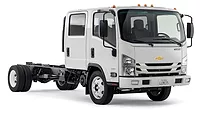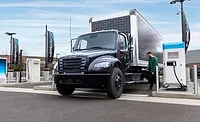2025 Trucks Report: New releases accelerate toward efficiency
Annual Truck Report looks at what’s in store from top distribution vehicle manufacturers

As the clock ticks down to the beginning of 2025, the major commercial truck original equipment manufacturers (OEMs) are promising a year full of a little something for everyone. Yes, there are the requisite updates on electric vehicles (and even a bit on the emerging autonomous truck sector), but there’s plenty of news to go around regarding more conventionally fueled offerings.
Whatever the fueling format, manufacturers are visibly ramping up their sustainability efforts across the board. Here’s a glimpse at what’s in store from the world’s top vehicle suppliers:

Daimler (Freightliner)
Daimler Truck North America unveiled its fifth-generation Freightliner Cascadia, sporting advanced safety features, increased aerodynamic efficiency, and the addition of new business intelligence tools.
The new iteration includes all-new, expanded capabilities for the Detroit Assurance Suite of Safety Systems. System updates include enhanced computing power and an upgraded camera, as well as four new short-range radar sensors and an improved long-range radar sensor ― all of which provide for new and updated safety offerings:
- Active Brake Assist 6 (ABA6) now is capable of adding automatic braking when detecting vehicles stopped at odd angles, vehicles in curves, stopped vehicles across multiple lanes, and recognizing both moving ― and now ― stationary pedestrians.
- Active Lane Assist 2 (ALA2) in addition to previous capabilities, now features Lane Change Assist ― which can help mitigate out-of-lane accidents by providing counter steering in case a truck attempts to enter an already occupied lane.
- Attentive Driver Protection with Lane Keep Assist, a feature of ALA2, is on and active ― this monitors driver attention through steering wheel input and can initiate a sequence that keeps the Cascadia centered in its lane, slows the vehicle to a stop and turns on the hazard lights if the driver is not responsive.
- Side Guard Assist 2 (SGA2) now is able to detect and warn drivers about objects on the driver side as well as the passenger side of the vehicle, from the cab to the end of the trailer.
Additionally, the fifth-generation Cascadia features an all-new Intelligent Braking Control System (IBCS), which includes brake-by-wire technology combined with backup pneumatics. It employs wheel speed sensors and a chassis-mounted electronic control unit to help provide advanced deceleration control. IBCS allows for the introduction of Comfort Braking, which provides brake force distribution, lining wear control and performance monitoring. These features ensure smoother braking, particularly in sudden stops, and help to elongate brake pad life through even wear.
IBCS also includes Endurance Braking, a feature that seamlessly blends the engine retarder and service brakes when the foot pedal is applied, helping to further extend brake life. An all-new electronic park brake enables Rollaway Mitigation, which is designed to automatically apply the parking brake when a driver leaves the seat or opens the door without setting the brake to help prevent costly rollaways and improve safety.
Also new are the Dual Stage Intelligent LED Headlights, which offer increased durability and impact resistance. The truck also offers a factory-installed MirrorCam System — a state-of-the-art camera system that enhances driver visibility.
Meanwhile, Daimler has married two of the biggest emerging technologies in the form of the autonomous Freightliner eCascadia demonstrator. The truck is based on a production battery electric Freightliner eCascadia and is equipped with autonomous driving software from Torc Robotics — Daimler’s independent subsidiary for autonomous vehicle technology — and the latest Level 4 sensor and compute technology. This eventually will enable Level 4 autonomous driving. Although still a research and advanced engineering project, the autonomous vehicle has the potential to evolve into a modular, scalable platform that is propulsion agnostic for flexible use in different trucking applications. It’s the first time since the batter-electric eCascadia first went into production in 2022 that it will feature an autonomous sensor suite and compute power, which is currently being used on the diesel-powered Cascadia.

Ford
Ford is offering some new options for its 2025 Fort Transit and E-Transit vans. The new starting MSRPs offers Ford’s fleet customers the flexibility to choose the powertrain that works best for their operations, gas or electric.
Four available factory-installed trade packages with components by Ranger Design are tailor-made to leading industries — including distribution — which helps shorten the order-to-delivery process. Packages can be financed together with the vehicle purchase, which helps streamline the process and eliminate separate upfit financing. There’s also a three-year, 36,000-mile warranty and service available at more than 2,800 Ford dealership locations nationwide. Shelves, drawers, and work surfaces are tailored to the specific needs of the fleet owner’s industry.
Additional new options include a wall liner kit for the ceiling, wall, and door, which also includes lighting and wheel well covers that will help ease the installation of upfit equipment; and a large grab handles kit to support easier accessibility. There’s an optional mobile power cord, which now includes a fast charger adapter. And smart acceleration truncation now is available as a standalone option for fleets, which can help managers improve driver behavior by limiting acceleration based on auto-calculation of the payload — which would enable a smooth start after every stop, regardless of the size of the load or the driver’s skill level. Starting MSRPs for 2025 Fort Transit models are as follows:
- 2025 E-Transit and comparable Transit cargo van models: $51,000
- 2025 E-Transit Chassis Cab: $46,200
- 2025 E-Transit Cutaway: $45,700

International
Possibly the biggest news out of International this year is that Navistar Inc. officially rebranded as International Motors LLC on Oct. 1. Company executives noted that after more than 120 years they’ve decided to return to the corporation’s roots as International.
It’s driven by a strategic shift to transform the business into a solutions provider and the role that the venerable International brand can play in a streamlined customer and user experience. While the trucks will continue to be at International’s core, the company’s full solutions portfolio also will include services such as parts, maintenance, financing, connectivity, and charging. The company unveiled a refreshed logo and overall visual identity to correspond with the shift.
In the months ahead, tools like OnCommand Connection and International 360 will converge under a new digital interface called My International, which, it says, will enhance and customize the customer experience by aligning all customer solutions and data, including service contracts, financing, and fleet management in one place.
Earlier this year, International took another step into the autonomous technology realm. As a member of the TRATON Group — of which it’s been a part since 2021 and whose other companies include Scania, MAN, International, and Volkswagen Truck & Bus — International is involved in a new partnership with Silicon Valley-based autonomous tech company Plus to integrate Plus’s Level 4 autonomous SuperDrive into International vehicles, as well as other vehicles within TRATON. Integrating the Plus Level 4 autonomous SuperDrive into International trucks will provide solutions for maintenance, telematics, safety, and reliability.
International also announced a suite of comprehensive ownership solutions for its full line of battery electric vehicles. This suite of comprehensive ownership solutions is available for either five or six years on every new battery-electric truck purchase and covers service intervals and parts pricing through convenient monthly payments available for financing through Navistar Financial to simplify BEV ownership throughout its entire lifecycle. International consultants assist fleets in their electrification journeys by understanding their unique needs, realizing the complexities of charging and infrastructure, and providing a thorough customer onboarding experience that involves driver and technician training. This approach provides customers confidence in their electrification transition with International.
Isuzu Commercial Truck of America
Isuzu announced the official start of production on its new chassis, the NRR-EV, the first of which rolled off the assembly line a few months ago.
The NRR-EV allows fleets to choose from four battery pack configurations: 10, 100, 140, or 180 kWh, depending on their individual range requirements. There’s 150-kW of max power, and 280-pound-feet of torque output with an operating voltage of 350 volts. Additionally, regenerative braking captures kinetic energy and transfers it into the batteries and the system allows the driver to set it according to their driving preference. It also features ECO mode, which helps to extend the truck’s range by reducing acceleration performance and battery consumption.
AC (level 2) and DC fast charging fully charges the vehicle in under two hours, while an advanced driver assistance system includes a lane departure warning system, an automatic emergency braking system, following distance warning, mis-acceleration mitigation, forward vehicle start notification, and full-range adaptive cruise control. Because the truck’s operation is so quiet, there’s a pedestrian alert system that notifies nearby pedestrians with audible cues that the truck is near when it’s operating at a low speed. Further, it includes an electric power take-off (ePTO) for powering auxiliary equipment. The company’s proprietary Isuzu Group Connect enables operators to remotely monitor cruising distance, battery level, charging status, and charging history.
The NRR-EV now is eligible for California Hybrid and Zero-Emission Truck and Bus Voucher Incentive Project (HVIP) funding. That means California-based fleets can qualify for up to a $60,000 HVIP voucher that can be stacked with other incentive programs. What’s more, Isuzu’s connected service, Isuzu360 will be an added resource for NRR-EV owners. The service offers owners an extension of their new vehicle warranty, complimentary scheduled service, and a variety of online tools to monitor their vehicles.
Mercedes-Benz USA
Mercedes-Benz USA announced some expansions to its eSprinter electric van line for 2025. As an alternative to the 113 kWh battery, 170-inch wheelbase, and high roof combination, Mercedes-Benz eSprinter customers in North America can now opt for an 81-kWh battery variant with different wheelbases and roof heights. This enables fleet managers to choose the right configuration for their specific applications in terms of payload and range.
With the different battery capacities, Mercedes-Benz says it can meet many customer needs and specific total cost of ownership requirements — from inner-city local transport to regional transport. To maximize a payload of up to 3,516 pounds, a 144-inch wheelbase with standard roof combination can offer up to 319 cubic feet of cargo volume. Alternatively, the longer 170-inch wheelbase with a high roof in combination with the 81 kWh battery allows for a total volume of 488 cubic feet and a payload of up to 3,120 pounds, almost 500 pounds more payload potential compared with the same configuration with the 113 kWh battery. All eSprinter variants allow for permissible gross vehicle weight of up to 9,370 pounds.
The eSprinter features a permanent magnet synchronous motor that enhances efficiency. It’s available with 100 kW or 150 kW peak power and delivers a torque of up to 295 pound-feet. An electric range for the 81 kWh battery of up to 329 kilometers (roughly 204 miles). For increased range, the 113 kWh battery offers a range of up to 478 kilometers (around 297 miles). Just like the 113 kWh battery, the 81 kWh option is capable of charging with both alternating current (AC) and direct current (DC). Fast charging with up to 115 kilowatts from 10 to 80% of full capacity can be achieved in just more than 30 minutes.

Nikola Motor
Diageo North America and contract logistics provider DHL Supply Chain have announced plans to incorporate two fuel-cell electric trucks, powered with hydrogen, to their U.S. fleet.
DHL Supply Chain, Diageo North America’s contract logistics partner for more than 20 years, has been actively working to develop innovative solutions that help to decarbonize its customers’ logistics operations. The hydrogen fuel cell electric trucks are part of a broader sustainable supply chain strategy that has included use of battery electric vehicles, optimizing vehicle usage and routes, shifting to a multimodal approach, and increased use of US EPA SmartWay partner carriers. These efforts have resulted in year-over-year reductions in carbon dioxide emissions for both Diageo and DHL.
Nikola's trucks use fuel cell technology to convert hydrogen into electricity, powering the vehicle's electric motors providing up to 500 miles in range on a single fill.
The trucks also offer significant improvements in driver comfort and safety by reducing noise and vibrations, leading to less driver fatigue. It also enhances visibility with advanced camera support.
Diageo’s presence in Plainfield, Illinois has expanded significantly over the years, playing a strategic role in its regional operations. This hub is home to manufacturing, bottling, and warehousing facilities, and it is instrumental in producing some of the company’s most iconic brands, like Captain Morgan and Smirnoff. Incorporating hydrogen fuel cell trucks into its fleet will contribute to Diageo’s broader efforts to reach net zero carbon emissions across direct operations by 2030 and its value chain by 2050 or sooner.

PACCAR (Peterbilt and Kenworth)
Peterbilt recently announced that the PACCAR TX-12 transmissions are available with PACCAR PX-9 engines on Peterbilt medium-duty models 548, 537, and 536. Both the standard PACCAR TX-12 and TX-12 PRO versions integrate with the PX-9 offering, which the company says is “efficient operation and superior drivability.” The TX-12 is designed to be one of the most efficient on-highway transmissions and is known for its lightweight and robust construction. When combined with the PX-9 engine, it operates up to 1,250 pound-feet of torque with a maximum GCWR — gross combination weight rating — of 66,000 pounds for pick-up and delivery.
In Peterbilt in-cab news, the PACCAR brand in September announced the availability of its new infotainment system with support for Apple CarPlay. The system features an intuitive user interface with enhanced connectivity, navigation, and entertainment options. Among the elements it includes are both wireless and wired Apple CarPlay support, enabling drivers to get directions, make calls, send and receive messages interact with supported apps, and more from the infotainment center. Additional features include AM/FM/weather and SiriusXM, analog high-definition (HD) camera support with split-screen viewing capability, embedded truck-specific navigation inclusive of Peterbilt and PACCAR powertrain service locations, including map updates at no extra cost for three years; multiple language support; wireless connectivity support for Android devices, and improved performance, user experience and updated operating system.
On the Kenworth side of things, the truck brand has introduced the PACCAR MX-13, California Air Resources Board (CARB)-compliant engine for its T680, T880, and W990 models. MX-13 CARB-compliant engine features new aftertreatment hardware that meets stringent California low nitrogen oxide (NOx) emissions requirements. To meet the more stringent CARB emissions requirements, the engine employs a twin-canister selective catalytic reduction (SCR) aftertreatment along with more optimized emissions controls systems. It’s available in two options: a 510-horsepower rating with 1,850 pound-feet of torque and a 455-horsepower rating with 1,650 pound-feet of torque. Both ratings allow for “superior performance and drivability without compromise on fuel economy,” the company says.

Volvo Trucks
Next year, Volvo Trucks plans to push the limits on EV range with the launch of a new long-range version of its FH Electric that will be able to reach up to 600 kilometers (about 373 miles) on a single charge.
Volvo’s new driveline technology — the “e-axle,” which creates space for significantly more battery capacity on board — will help make such range possible. More efficient batteries, an improved battery management system, and overall efficiency of the powertrain also will play a role in the extended range.
Volvo also announced that it’s increasing the use of low-CO2-emission steel, produced with recycled material and fossil-free energy, on tens of thousands of its trucks beginning in 2025. As a result, CO2 is reduced by around 80% compared with the production of conventional steel using fossil energy, according to Volvo.
Next year, the frame rails in around 12,000 Volvo FH and FM trucks will be made of low-CO2-emission steel. This will result in savings of 6,600 tons of CO2 equivalents. As the availability of low-CO2-emission steel increases, it will be introduced in more truck models as well as in other parts of the truck.
Volvo also is planning to replace other materials in its trucks with lower emissions alternatives. The potential for lowering CO2 emissions is maximized as nearly half of the truck is made of steel (47% of a Volvo FH diesel truck), and it represents about 44% of the CO2 emissions from the production (cradle to gate) out of the total 21 tons CO2 equivalents for the Volvo FH diesel.
Volvo Group is collaborating with several suppliers around low-CO2-emission steel. Low-CO2-emission steel will be an important complement to the traditional and recycled steel used in Volvo’s trucks. The main materials in a Volvo FH diesel truck are steel (47%), cast iron (26)5, polymers (11%), and aluminum (8%). They stand for around 44%, 26%, 14% ,and 8% of the CO2 emissions from the production (cradle to gate) out of the total 21 tons CO2 Equivalents for the Volvo FH diesel.
Looking for a reprint of this article?
From high-res PDFs to custom plaques, order your copy today!








